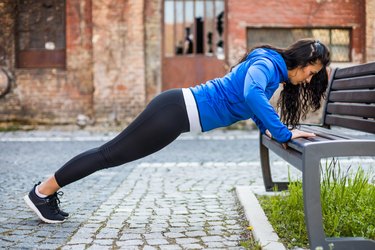
For many people, periods are tough to manage. Pile an autoimmune disease on top, like rheumatoid arthritis, and you may feel double the discomfort during "that time of the month."
Rheumatoid arthritis (RA) is an autoimmune disease where your immune system mistakenly attacks tissues in your joints, causing inflammation in areas like your knees, hips, hands and wrists. This can cause pain and swelling.
Video of the Day
Video of the Day
But what does this have to do with your period?
Read on to hear from rheumatologists about the connection between PMS and arthritis and get tips on how to feel better during your flow.
A Note on Language
Here at LIVESTRONG.com, we try to avoid language that implies a sex or gender binary in favor of more inclusive language, but we sometimes include words like "men" or "women" when quoting an expert or other original source material for the sake of accuracy.
The Link Between RA and Your Period
In short: Yes, rheumatoid arthritis symptoms can get worse on your period. There are a couple reasons why:
1. Estrogen Levels Affect RA Symptoms
Turns out, the rise and fall of estrogen (an important reproductive hormone) during your cycle may have an effect on your RA symptoms, per the National Institutes of Health (NIH). In fact, many people report RA flare-ups during their period, or even around the time that estrogen decreases in the body (i.e., right before menstruation and right after ovulation).
"During a menstrual cycle, a decrease in the estrogen levels prior to and during a woman's period can lead to increased joint inflammation and fatigue," says Teja Kapoor, MD, a rheumatologist and assistant professor at Columbia University Medical Center.
Estrogen has anti-inflammatory properties, per an October 2020 review in the Journal of Neuroinflammation. Because RA is an inflammatory condition, it makes sense that having more anti-inflammatory estrogen in your body might lessen arthritis symptoms, while having less of the hormone would have the opposite effect.
This is also why people with RA may notice an increase in symptoms during menopause, as estrogen levels drop dramatically during this time, per the Centers for Disease Control and Prevention (CDC).
Dr. Kapoor also says RA activity tends to decrease during pregnancy, when estrogen levels are high and you have no period.
2. Symptoms Can Compound
Common symptoms of PMS, per the American College of Obstetricians and Gynecologists (ACOG), include aches and pains, swelling of the hands and feet, gastrointestinal problems and abdominal pain. These overlap with symptoms of rheumatoid arthritis flares, per the Cleveland Clinic.
Once you get your period, you may also feel more tired, causing you to lie down or stay in bed longer. This inactivity and lack of movement can lead to more joint pain and soreness associated with RA.
Unfortunately, this is what makes it difficult to manage arthritis on your period, as you can feel the symptoms of both conditions at the same time. But there are several things you can do to ease your discomfort.
Treatments to Manage RA Flares on Your Period
It can be difficult to deal with symptoms of RA flare-ups. Add that to the discomfort of PMS and menstruation, and you may feel you need some extra help.
"RA flares during the menstrual period can oftentimes be managed using a conservative medical approach," says Adam Kreitenberg, MD, board-certified rheumatologist and contributor to 1MD Nutrition.
Conservative approaches suggested by both Dr. Kreitenberg and Dr. Kapoor include the following:
1. Oral Analgesics
Good EvidenceNon-steroidal anti-inflammatory drugs (NSAIDs) like ibuprofen and naproxen help reduce inflammation and are often a first line of defense for relieving both joint pain and uterine contractions caused by menstruation.
Brand-name NSAIDs include Motrin ($12.47, Amazon), Advil ($9.98, Walmart) and Aleve ($10.19, Amazon).
Keep in mind that pain relievers with acetaminophen (e.g. Tylenol) can help with pain, but they do not bring down inflammation.
2. Topical Analgesics
Good EvidenceIf you're dealing with joint pain, you can try a topical pain-relief cream like Voltaren, which is designed specifically for arthritis ($10.46 at Walmart; $27.48 for a 2-pack at Amazon).
Voltaren contains the active ingredient diclofenac sodium, which is a topical anti-inflammatory that delivers targeted pain relief.
3. Disease-Modifying Antirheumatic Drugs (DMARDs)
Good EvidenceMany people with RA that interferes with daily life are prescribed disease-modifying antirheumatic drugs, or DMARDs, per the National Library of Medicine (NLM).
These medications can reduce joint inflammation, which can improve movement in the joints and reduce pain.
"Remaining on your RA DMARD medications can help control much of your RA flare," Dr. Kapoor says. "If the RA flare is significant, it is important to reach out to your rheumatologist to adjust your medications."
4. Warm Showers
Good EvidenceThe sensation of heat can help improve your pain tolerance and relax your muscles, both of which can reduce pain associated with RA, per Harvard Health Publishing. It's also known that heat can help relieve menstrual cramping, per Houston Methodist Hospital.
This is why it may be helpful to hop in a warm shower when you're experiencing a flare during your period, to let the warm water soothe your pain points.
5. Heating Pads
Good EvidenceJust like warm water can be soothing, purchasing a good quality heating pad or heated blanket could help you feel relief throughout the day, or when going to sleep at night. (Here's a list of our top heating pad picks.)
6. Gentle Exercise
Some EvidenceGetting the body moving can help ease RA symptoms, per the Arthritis Foundation, and it may also relieve PMS symptoms, per a September 2022 study in BMC Sports Science, Medicine and Rehabilitation. Plus, the endorphins from exercise may just make you feel calmer overall.
Try something light like walking or yoga to get moving.
4. An Anti-Inflammatory Diet
Some EvidenceThere isn't a particular diet or food that will cure RA, but there are foods that are anti-inflammatory in nature, which will help reduce swelling and pain. These include, per the Arthritis Foundation:
- Fatty fish like salmon and tuna
- Nuts and seeds
- Fruits and vegetables high in vitamins C, E, K and antioxidants, like citrus fruits, broccoli, blueberries and cherries
- Olive oil
- Beans
- Whole grains like wheat bread and oatmeal
Foods that reduce inflammation may also help relieve symptoms caused by your period, per the Physicians Committee for Responsible Medicine.
7. Natural Remedies
Limited EvidenceThere are a few herbs and spices that have shown a potentially positive effect on inflammation in the body — curcumin and boswellic acid.
While evidence is limited, one comparative January 2018 clinical trial in BMC Complementary and Alternative Medicine found that curcumin and boswellic acid were associated with a reduction in pain in participants with arthritis.
Curcumin is an agent found in the root turmeric, which is used in cooking for flavor and for its bright yellow color. It also has antioxidant and anti-inflammatory properties, per the Linus Pauling Institute.
You can get curcumin from eating turmeric in meals or by taking turmeric supplements (although you should check with your doctor before trying the latter, to make sure a supplement won't interfere with your medications or cause other unwanted side effects).
Boswellic acid comes from the boswellia plant — also known as frankincense. It is used in alternative medicine to treat inflammation and arthritis, per the Memorial Sloan Kettering Cancer Center. However, more research needs to be done on its efficacy.
The Bottom Line
While there are few studies that draw a connection between RA flare-ups and your period in particular, the drop in estrogen you experience before and during your period could contribute to heightened RA symptoms.
Plus, it's a common complaint that many rheumatologists like Dr. Kapoor see in their practice.
That means, if you're experiencing RA pain and inflammation during your period, it's worth bringing up to your doctor, and finding a treatment that works for you.
"Your doctor can also help you develop a plan for the week before and during your period, so you can reduce pain and prevent flare symptoms," Dr. Kapoor says.
- The Normal Menstrual Cycle and the Control of Ovulation
- Cleveland Clinic Journal of Medicine: "Estrogen, progesterone, and testosterone: Can they be used to treat autoimmune diseases?"
- Annals of the New York Academy of Sciences: "Epidemiological aspects of rheumatoid arthritis: The sex ratio"
- CDC: "Rheumatoid Arthritis (RA)"
- Journal of Neuroinflammation: "The peri-menopause in a woman’s life: a systemic inflammatory phase that enables later neurodegenerative disease"
- ACOG: "Premenstrual Syndrome (PMS)"
- Arthritis Foundation: "RA and Gastrointestinal Problems"
- Cleveland Clinic: "Rheumatoid Arthritis"
- BMC Sports Science, Medicine and Rehabilitation: "The relationship between high physical activity and premenstrual syndrome in Japanese female college students"
- Arthritis Foundation: "The Ultimate Arthritis Diet"
- Harvard Health Publishing: "Heat therapy for rheumatoid arthritis"
- Houston Methodist Hospital: "Menstrual Cramps: 5 Tips for Getting Relief From Period Pain"
- NLM: "Disease Modifying Anti-Rheumatic Drugs (DMARD)"
- Linus Pauling Institute: "Curcumin"
- BMC Complementary and Alternative Medicine: "Efficacy and safety of curcumin and its combination with boswellic acid in osteoarthritis: a comparative, randomized, double-blind, placebo-controlled study"
- Memorial Sloan Kettering Cancer Center: "Boswellia"
- Physicians Committee for Responsible Medicine: "Using Foods Against Menstrual Pain"
- Arthritis Foundation: "Best Exercises for Rheumatoid Arthritis"
Is this an emergency? If you are experiencing serious medical symptoms, please see the National Library of Medicine’s list of signs you need emergency medical attention or call 911.


